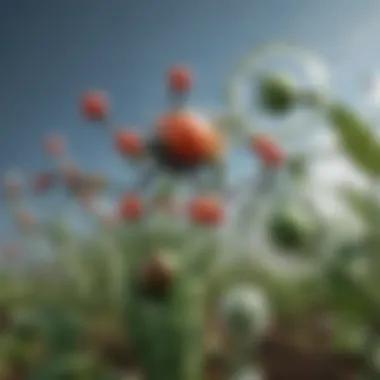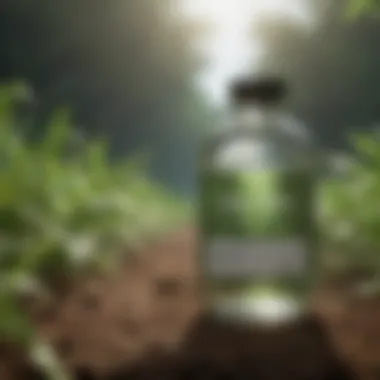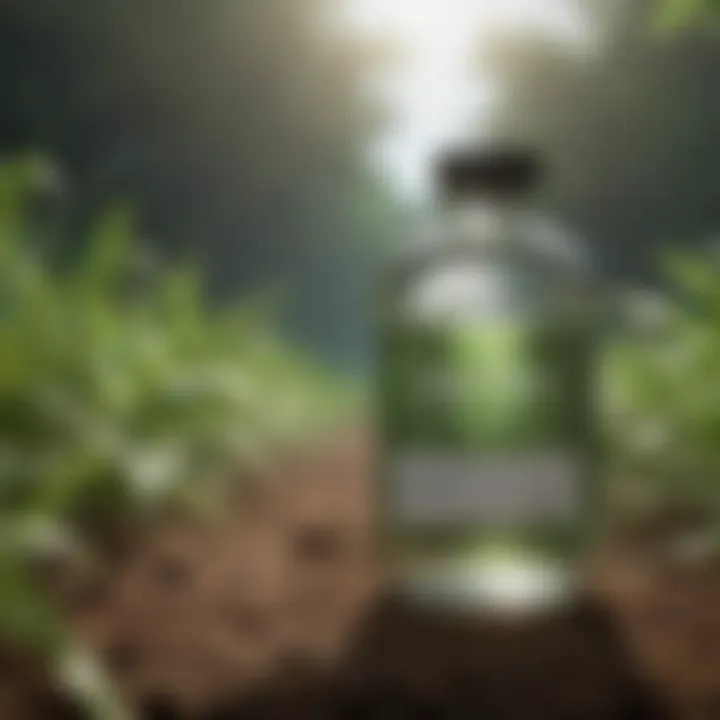Understanding Pesticides: Their Role and Impact


Intro
Pesticides play a crucial role in modern agriculture and beyond. Their primary function is to protect crops from various threats, such as pests, weeds, and diseases that can undermine productivity and the quality of food supply. This article will explore the multifaceted applications of pesticides, their classifications, and their implications for health and the environment. As we navigate through these topics, we will highlight the importance of understanding the balance between the necessity of pesticides in food production and the potential risks associated with their use.
Many may not realize that pesticides extend beyond agricultural use. They are also utilized in industries such as public health, where they help manage vector-borne diseases, and in residential environments to protect homes from structural damage caused by pests. This comprehensive understanding will empower readers to engage critically with the subject.
Methodology
Overview of research methods used
In analyzing the role of pesticides, a structured methodology is crucial. The research methods integrate both qualitative and quantitative approaches. This includes reviewing scientific literature, industry reports, and regulatory documents. Case studies from various regions can provide real-world examples of pesticide use and impact.
Data collection techniques
Data can be collected through several techniques, such as surveys and interviews with agricultural professionals and experts. Additionally, environmental impact assessments help gauge the effects of pesticides on ecosystems. Monitoring pesticide residues in food and water sources provides insight into the safety and regulation of these substances. This mixed-method approach ensures a well-rounded assessment of the topic.
Future Directions
Upcoming trends in research
Research in pesticides is evolving, focusing on safer alternatives and reduced environmental impact. There is a growing interest in biopesticides and integrated pest management practices. These strategies aim to minimize chemical use while maintaining effective pest control.
Areas requiring further investigation
Despite advancements, several areas require further research. Long-term environmental effects, human health implications, and the development of regulations that keep pace with innovation are key areas for exploration. Delving into these topics will further enhance our understanding of pesticides and inform best practices in their use.
To address the challenges posed by pesticide reliance, collaborative efforts among scientists, regulators, and the agricultural sector are essential.
The journey into understanding pesticides is important for informed decision-making, sustainable practices, and the advancement of agricultural science. The discussion of pesticides is not merely about chemicals; it is a dialogue about food security, environmental stewardship, and public health.
Preamble to Pesticides
The significance of understanding pesticides is profound in the context of modern agriculture. Pesticides play a crucial role in ensuring food security, protecting crops from pests, weeds, and diseases that could devour entire harvests. They are chemical agents specifically formulated to maintain agricultural productivity and manage biological threats. The use of pesticides is not without controversy; it often raises questions about environmental sustainability, human health, and long-term agricultural practices. This article endeavors to provide a comprehensive view of pesticides. It will discuss their definitions, historical evolution, types, and applications, while also assessing the risks they introduce.
Definition of Pesticides
Pesticides can be defined as substances used to prevent, destroy, repel, or mitigate pests. The term encompasses a range of chemical agents including insecticides that target insects, herbicides for weeds, fungicides for fungi, and rodenticides for rodents. The precise formulation of these substances varies based on their intended target and mechanism of action. Essentially, pesticides disrupt the life cycle of pests, either by inhibiting growth, causing death, or preventing reproduction. Their application is vital in the agricultural sector to enhance crop yields and manage environmental threats to food production.
Historical Context
The historical development of pesticides dates back to ancient civilizations where substances like sulfur and arsenic were used to combat pests in agriculture. As societies advanced, so did the methods of pest control. In the early 20th century, with the advent of synthetic chemicals, the landscape of pest management shifted significantly. The introduction of DDT in the 1940s marked a turning point, showcasing the potential of chemical pesticides to control pests on a large scale. However, this also led to significant environmental and health concerns, resulting in regulatory actions and a reexamination of pesticide use. Over time, the industry has evolved towards developing safer and more targeted pesticide options, reflecting an ongoing commitment to addressing the challenges related to pest management, environmental sustainability, and public health.
Types of Pesticides
Understanding the types of pesticides is essential for grasping their role in agricultural practices and other industries. Each pesticide category serves a specific function, addressing different threats to crops and human health. Choosing the right type can mean the difference between successful management of pests, weeds, or diseases and ineffective treatment. It’s vital for researchers, students, and professionals to understand the distinctions and applications of various pesticides.
Insecticides
Insecticides are chemicals designed to target and manage insect populations that can harm crops or transmit diseases. These pesticides vary in mode of action; some disrupt the nervous system of insects, while others inhibit their growth or reproduction. The importance of insecticides to agriculture cannot be overstated. For instance, a farmer facing a locust invasion may find that timely application of insecticides is crucial for protecting their yield.
Using insecticides can be a double-edged sword. While they are effective in managing pests, there are concerns regarding their impact on non-target species, including beneficial insects like bees. Therefore, integrated pest management (IPM) practices often incorporate selective use of insecticides to minimize negative consequences.
Herbicides
Herbicides are specifically formulated to eliminate unwanted plants, commonly known as weeds. Weeds compete with crops for precious resources like sunlight, nutrients, and water. Hence, effective herbicide use can significantly enhance crop yield and overall agricultural productivity. There are pre-emergent and post-emergent herbicides, each used at different growth stages of both crops and weeds.
The challenge lies in selecting the proper herbicide for specific weed species, as over-reliance on a narrow range can lead to resistance. This resistance necessitates evolving strategies such as crop rotation and the use of multiple herbicides to manage resistant weed populations. Failing to address these issues can have long-term implications on crop health and yield.
Fungicides
Fungicides play a critical role in controlling fungal diseases in crops. These diseases can severely affect crop yield and quality. Fungal pathogens thrive in certain environmental conditions, making crops susceptible to infection and losses. The timely application of fungicides is often vital for ensuring healthy crops, particularly in humid climates.
There are different classifications of fungicides, including protectants, which prevent fungus from colonizing the plant, and eradicants, which are used after infection occurs. Understanding the life cycle of the pathogen and the optimal application timing can greatly enhance the effectiveness of these chemicals in preserving crop health.
Rodenticides
Rodenticides are a class of pesticides specifically designed to eliminate rodents, which can damage crops and spread disease. Agriculture is particularly affected by rodent infestations; these animals consume stored grains and can transmit pathogens to livestock. Effective rodent control strategies involve understanding the habits and populations of local rodents.
The application of rodenticides often requires strict adherence to safety regulations to prevent unintended harm to non-target species, including pets and wildlife. The use of bait stations and traps can provide controlled means of rodent management without relying solely on chemical solutions.
In summary, the various types of pesticides—each serving distinct roles in pest, weed, and disease management—highlight their importance in agriculture and beyond. A thorough understanding of these categories can inform effective practices that enhance agricultural productivity while considering environmental and health impacts.
Applications of Pesticides in Agriculture


The application of pesticides in agriculture serves as a critical element in modern farming practices. These chemical agents play pivotal roles in protecting crops from various threats, which in turn supports food security on a global scale. Ensuring that crops thrive amid challenges such as pests, weeds, and diseases requires a strategic use of pesticides. A clear understanding of this subject helps educators, students, and researchers recognize the balance between agricultural productivity and the safety of ecosystems.
Crop Protection
One of the primary applications of pesticides is crop protection. Farmers utilize insecticides, herbicides, and fungicides to defend their fields against harmful species that threaten crop yield. Healthy crops are vital for sustaining economic growth in the agricultural sector. For example, the use of insecticides specifically targets insects that feed on plants, which can dramatically reduce damage and loss.
Additionally, maintaining biodiversity by controlling pest populations ensures that crops can develop without excessive interference. However, it is essential to apply these chemicals judiciously to minimize potential harm to non-target species and the environment. Over-reliance on chemical protection can lead to pesticide resistance, presenting a significant challenge for farmers. Therefore, adhering to integrated management techniques becomes crucial in fostering long-term crop success.
Weed Management
Weed management is another significant area where pesticides prove invaluable. Uncontrolled weeds compete with crops for essential resources, including nutrients and water. The application of herbicides allows farmers to selectively manage weed populations while safeguarding their desired crops. This targeted approach minimizes the amount of labor required for mechanical weeding and significantly lessens the risk of crop damage.
Using herbicides can simplify the farming process, allowing more efficient resource allocation and time savings. However, improper use of herbicides can lead to weed resistance and reduced agricultural yield. Thus, farmers should combine chemical strategies with practices like crop rotation and mulching. Such integrated approaches can support more sustainable weed management, benefiting both the land and crop production.
Disease Control
Disease control is another critical application of pesticides in agriculture. Fungal infections, bacterial issues, and viral diseases can devastate crops, leading to severe economic repercussions. Fungicides are routinely employed to protect against fungal pathogens that can jeopardize plant health and market availability.
Preventive measures through timely application of fungicides can enhance crop resilience against diseases. Employing disease-resistant varieties is another tool that complements chemical use. This dual approach allows for effective management of plant health without solely relying on pesticides. However, awareness and education regarding the potential long-term effects of such pesticides on soil and plant health remains vital for sustainable farming practices.
Fumigation Practices
Fumigation practices involve the use of gaseous pesticides to exterminate pests within stored products or soil. This method is particularly relevant in preventing pest invasions in crops after harvest, which can lead to significant financial losses. Fumigation can be an effective solution to eliminate tough pest populations that traditional methods may not handle adequately.
However, safety concerns arise with fumigation due to the potential risks to human health and environmental impacts. Proper training and adherence to safety regulations are essential for anyone involved in the fumigation process. This practice should be viewed as part of an integrated pest management strategy to ensure sustainable usage while maximizing effectiveness.
"The efficacy of pesticides is balanced against the need to protect the environment and public health. Sustainable practices in applications are essential for the future of farming."
In summary, the applications of pesticides in agriculture are multifaceted and inherently vital in modern farming. While their benefits are significant in enhancing crop protection, weed management, disease control, and fumigation practices, careful consideration of their impact on the environment and human health is essential. This balance underscores the importance of sustainable practices that can help protect both agricultural productivity and the ecosystems affected by these chemicals.
Role of Pesticides in Non-Agricultural Settings
The role of pesticides in non-agricultural settings is significant yet often overlooked. Pesticides are not just confined to farming practices; they extend their utility into urban environments, public health, and the maintenance of structures. Understanding these aspects is crucial for comprehending the full impact of pesticide use in society. The benefits range from pest control to disease prevention, highlighting their essential role in maintaining health and safety standards in various settings.
Urban Pest Control
Urban pest control is an important aspect of maintaining public spaces and private residences. Pesticides are used to combat a variety of pests, including rodents, insects, and other vermin that can pose risks to health and property. The presence of pests in urban settings can lead to food contamination, property damage, and the transmission of diseases.
Methods of urban pest control involve targeted pesticide applications that minimize exposure to humans and non-target species. Products such as pyrethroids are commonly used due to their rapid action against insects. Integrated pest management (IPM) practices are increasingly adopted. IPM combines chemical controls with behavioral and environmental modifications, offering a more sustainable approach to urban pest control.
"Integrated pest management is a holistic approach that combines different strategies to manage pests effectively while minimizing risks to human health and the environment."
Public Health
The concept of public health encompasses the efforts to protect the health of entire populations. Pesticides play a dual role in this area by controlling pests that are carriers of diseases and also by ensuring sanitary conditions in community settings. Mosquito control programs, for instance, utilize larvicides and adulticides to manage populations that transmit diseases like West Nile Virus and Zika. By reducing the number of disease-carrying pests, public health initiatives can effectively lower infection rates.
Another vital aspect is the enforcement of health regulations within urban environments. Public health agencies rely on pesticides to manage vector-borne diseases, maintaining a healthier living environment for residents. The use of pesticides must, however, be balanced with safety assessments to avoid any adverse health effects related to exposure.
Structural Protection
Structural protection pertains to the use of pesticides in preserving and safeguarding buildings and infrastructure from pests that can cause structural damage. Termites are a prime example; they can significantly weaken the integrity of a structure, leading to costly repairs and even potential safety hazards.
Pesticides, such as borate solutions, are applied to wooden components during construction or as a preventative treatment on existing structures. Regular inspections and maintenance protocols that include pesticide applications can drastically reduce the risk of infestations. Furthermore, the use of pesticides can extend to mold and fungus control, protecting the health of individuals by ensuring clean air quality within structures.
Environmental Impact of Pesticides
The environmental impact of pesticides is a critical area of concern. Pesticides, while effective in managing pests, weeds, and diseases, can have far-reaching effects on ecosystems. Understanding these impacts is essential in fostering a balance between agricultural productivity and environmental sustainability. Key elements include biodiversity, soil health, and water quality, each influencing and reflecting the broader implications of pesticide use.
Effects on Biodiversity
Biodiversity refers to the variety of life in a given ecosystem. Pesticides can negatively affect it by reducing populations of non-target species. This not only impacts insects but also birds and mammals that rely on these insects for food.
Research indicates that certain insecticides, particularly neonicotinoids, are implicated in declining bee populations. Bees play a vital role in pollination, essential for many crops and flowering plants. The loss of these pollinators can lead to decreased crop yields and affect food security.
The introduction of herbicides can equally disrupt plant communities, often leading to monocultures that diminish habitat variability. As species diminish, the entire ecosystem becomes less resilient to environmental changes.
Soil Health Concerns
Soil health is fundamental to agricultural productivity and ecosystem sustainability. Pesticides can alter soil microbiomes, affecting beneficial microorganisms necessary for nutrient cycling and organic matter decomposition. The long-term use of chemical pesticides may result in reduced soil fertility, impacting crop health and yield.
Moreover, certain pesticides can lead to soil acidification and deterioration. This can create a cascading effect, reducing the ability of plants to recover nutrients from the soil. Practices like Integrated Pest Management aim to mitigate these impacts by combining biological control and reduced chemical reliance.
Water Quality Issues
The application of pesticides can lead to water quality degradation. Runoff from treated fields can transfer pesticide residues into nearby water bodies. This not only affects aquatic life but can also contaminate drinking water sources.


Studies have shown that herbicides such as glyphosate have been detected in rivers and lakes, raising concerns about the long-term effects on aquatic ecosystems. The contamination can harm fish, amphibians, and other organisms, disrupting their reproductive processes. Furthermore, the presence of pesticides in drinking water poses health risks to humans, underscoring the need for regulated pesticide use.
Health Risks Associated with Pesticides
The topic of health risks associated with pesticides is paramount in understanding their multifaceted impacts on human health and safety. Pesticides are widely used in agriculture and other industries, leading to potential exposure for various populations. Recognizing how these chemicals can affect health is critical for ensuring safe practices in their application. Furthermore, public awareness and regulatory measures rely on such understanding to mitigate any adverse effects.
Human Exposure Pathways
Exposure to pesticides can occur through several pathways. The primary methods include:
- Dermal contact: This occurs when pesticides touch the skin, which can happen during application or handling.
- Inhalation: Breathing in aerosolized pesticides is particularly relevant for agricultural workers and residents near treated fields.
- Ingestion: Consuming contaminated food or water can introduce pesticides into the body.
Assessing these pathways is crucial for identifying at-risk groups, particularly agricultural workers, children, and those living near agricultural areas. Understanding the specific routes of exposure helps in implementing protective measures, such as wearing appropriate personal protective equipment and following safety guidelines during pesticide application.
Acute Toxicity
Acute toxicity refers to the immediate effects that can result from high-dose exposure to pesticides. Symptoms can range from mild irritation to severe health issues. Common acute effects include:
- Nausea and vomiting
- Headaches
- Dizziness
- Respiratory difficulties
- Neurological symptoms like seizures or tremors
Recognizing these symptoms is vital for quick diagnosis and treatment. For example, individuals working with pesticides should be trained to identify such signs and seek medical help promptly if conditions arise. Regulatory bodies often categorize pesticides based on their acute toxicity, helping in formulating guidelines for safer usage.
Chronic Health Effects
Chronic health effects develop over the long term from repeated or prolonged exposure to pesticides. These effects can be insidious and include:
- Respiratory diseases
- Neurological disorders
- Reproductive issues, including infertility
- Cancer, with specific pesticide classes linked to certain types of tumors
The significance of studying chronic effects is seen in the increasing regulations surrounding pesticide usage. The long-term surveillance of exposed populations often reveals correlations between pesticide use and various chronic health conditions. Continuous research is necessary to fully understand these implications and advocate for safer practices in pesticide application.
"Understanding health risks associated with pesticides is pivotal not only for regulatory practices but also for protecting vulnerable populations and ensuring sustainable agricultural practices."
In summary, awareness of health risks informs better policy, more effective education for pesticide applicators, and ultimately improved public health outcomes.
Regulatory Framework for Pesticide Use
The regulatory framework surrounding pesticide use is crucial for ensuring both public health and environmental safety. Regulations are designed to control how pesticides are manufactured, distributed, and applied. They create a balance between agricultural productivity and safety for humans and ecosystems. Without effective regulation, there could be widespread misuse of pesticides, leading to detrimental health effects and environmental degradation.
Clear guidelines and policies help to manage the risks associated with pesticide application. These regulations are often informed by scientific research and public input. This involvement ensures that a diverse set of concerns is considered. Understanding the regulatory processes is essential for anyone involved in agriculture or pest management.
Approval Processes
The approval process for pesticides is an extensive procedure that assesses the safety and efficacy of chemical products before they reach the market. Various government agencies, such as the Environmental Protection Agency in the United States, are responsible for evaluating these substances.
Typically, the approval process includes several steps:
- Submission of Application: Companies must submit detailed data on pesticide formulation, proposed uses, and studies demonstrating efficacy and safety.
- Scientific Review: Independent scientists assess the provided data. This review evaluates potential risks to human health and the environment.
- Public Commentary: During certain periods, the public can comment on new pesticide approvals, allowing for community input.
- Decision: After reviewing all data and public opinions, the regulatory agency decides whether to approve, reject, or conditionally approve the pesticide.
These steps ensure that only pesticides demonstrating a significant benefit and minimal risk are authorized for use.
Labeling Requirements
Labeling is another critical component of pesticide regulation. Labels provide essential information on safe use, application methods, and first-aid measures. They are not just recommendations; they are legally binding. Users must adhere to label instructions to remain compliant with the law. This can include details about:
- Target pests: Identification of which pests the pesticide is effective against.
- Application rates: Specific amounts that can be safely used on crops.
- Pre-harvest intervals: Time required between pesticide application and when crops can be harvested.
- Safety precautions: Necessary protective gear and actions to take in case of exposure.
Having clear, informative labels minimizes the risk of improper use, which can harm both health and the environment.
Safety Assessments
Safety assessments are integral parts of the pesticide approval process. These evaluations measure both the acute and chronic effects of pesticides on human health and the environment. Researchers conduct animal studies, ecological assessments, and long-term exposure evaluations to gather comprehensive data.
Risk assessment involves:
- Hazard identification: Determining whether a substance has the potential to cause harm.
- Dose-response assessment: Understanding the relationship between exposure levels and health effects.
- Exposure assessment: Estimating the potential human and environmental contact with the pesticide.
- Risk characterization: Integrating hazard and exposure data to evaluate overall risks.
"The safety assessment process is vital to ensuring that pesticides used in agriculture do not pose significant risks to human health and the environment."
These structured approaches provide a scientific basis for regulatory decisions, ensuring that pesticides on the market are safe for users and surrounding ecosystems.
Sustainable Practices in Pesticide Use
Sustainable practices in pesticide use are essential for minimizing negative impacts on health and the environment while ensuring agricultural productivity. Using pesticides cannot be avoided completely, but their application can be managed to achieve a balance between effectiveness and ecological responsibility. This wraps into a broader conversation about sustainability, which considers long-term outcomes for both humans and ecosystems alike.
Integrated Pest Management


Integrated Pest Management (IPM) is a cornerstone of sustainable pesticide practices. IPM incorporates various strategies to manage pest populations while reducing reliance on chemical controls. This approach includes biological control methods, cultural practices that enhance crop resilience, and mechanical interventions such as traps.
Key benefits of IPM include:
- Reduced Chemical Use: By using a combination of methods, farmers can lower their pesticide application rates, which leads to less chemical runoff into the environment.
- Cost Efficiency: Reducing unnecessary pesticide applications can save money for farmers in the long run.
- Resistance Management: IPM helps in preventing the development of pesticide-resistant pests, prolonging the efficacy of existing chemicals.
By implementing IPM, farmers can address pest issues more holistically, ensuring that all factors affecting crops are considered.
Biopesticides
Biopesticides present another sustainable alternative to traditional pesticides. Derived from natural materials, these products can include microorganisms, plant extracts, and essential oils. Biopesticides can be effective against specific pests and offer several advantages over conventional pesticides.
Some notable advantages include:
- Environmental Safety: Biopesticides are generally less harmful to non-target organisms, including beneficial insects and soil microbes.
- Decomposition: Many biopesticides break down more quickly than synthetic chemicals, reducing the risk of long-term environmental residues.
- Targeted Action: They often act in ways that minimize disruption to surrounding ecosystems.
Despite their benefits, the effectiveness of biopesticides can vary based on environmental conditions, which necessitates careful consideration of how and when to use them effectively.
Organic Farming Considerations
Organic farming places a significant emphasis on sustainable pesticide practices. Chemical pesticides are generally prohibited in organic farming unless they are derived from natural substances that meet specific criteria. This approach encourages a range of practices aimed at maintaining soil health and promoting biodiversity.
Several considerations to keep in mind include:
- Soil Management: Healthy soils can lead to stronger plants that are better able to withstand pests and diseases.
- Crop Rotation and Diversity: Growing different crops in succession or in combination can disrupt pest life cycles and reduce dependence on pesticides.
- Use of Organic-approved Products: Organic-approved pesticides, such as certain plant-based extracts, can be used without compromising organic standards.
Emerging Trends in Pesticide Development
Emerging trends in pesticide development are crucial for understanding the future of agricultural practices. The increasing demand for food, coupled with the challenges posed by pests and diseases, has driven innovation in this field. Evaluating these trends reveals significant benefits, considerations, and implications for sustainable agriculture and public health.
Precision Agriculture
Precision agriculture represents a transformative approach that integrates technology into pest management. This method employs data analysis and geographic information systems (GIS) to apply pesticides in a targeted manner. By doing so, farmers can optimize their pesticide use, reducing waste and minimizing environmental impact. The detailed monitoring of crop health allows for timely intervention and reduces the risk of over-application, which can harm beneficial organisms and lead to pesticide resistance.
Key components of precision agriculture include:
- Variable Rate Technology (VRT): Farmers can adjust the amount of pesticide applied based on specific areas of the field, ensuring that only areas requiring treatment receive it.
- Remote Sensing: This technology allows farmers to assess crop health remotely, making it possible to detect issues before they escalate.
- Data-Driven Decisions: Access to real-time data enables informed choices about when and how much pesticide to apply, creating a more efficient use of resources.
By embracing precision agriculture, the agricultural sector can achieve higher yields while working towards sustainability.
Nanotechnology Applications
Nanotechnology is setting new frontiers in pesticide development through the creation of nanoparticles that enhance the efficacy of traditional pesticides. These nanoparticles can improve the delivery and absorption of chemicals, allowing for lower dosages to be effective. This technology can also lead to the development of slow-release formulations, which provide prolonged control of pests over time.
Some advantages of nanotechnology applications include:
- Enhanced Effectiveness: Nanoparticles can penetrate plant tissues more easily, ensuring better coverage and target precision.
- Reduced Environmental Impact: Lower pesticide usage leads to decreased residues in soil and water, contributing to improved ecological health.
- Targeted Delivery: Nanocarriers can be designed to release pesticides in response to specific stimuli, such as temperature or pH changes.
Such innovations could revolutionize how agrochemicals are developed and used, paving the way for more responsible and efficient agricultural practices.
Regenerative Agriculture
Regenerative agriculture emphasizes building healthy soils and ecosystems, often incorporating reduced pesticide usage as a core principle. This approach not only focuses on productivity but also on enhancing biodiversity and soil health. Farmers practicing regenerative methods may integrate cover crops, crop rotations, and reduced tillage, all of which help create natural pest control mechanisms.
In this context, pesticide use becomes more about integrative solutions rather than reliance on chemical interventions. Some techniques include:
- Biological Control: Utilizing natural predators and parasites of pests can reduce the need for synthetic pesticides.
- Soil Health Improvement: Healthy soils foster more resilient crops that can better withstand pest pressure, thereby reducing chemical dependency.
- Enhanced Ecosystem Services: Healthy ecosystems can provide various benefits, such as pollination and pest control, which are vital for sustainable agriculture.
Regenerative farming practices signify a shift towards resilience, allowing agricultural systems to adapt to environmental changes and reduce chemical dependencies.
"As agriculture progresses, the intersection of biotechnology, technology, and sustainable practices will redefine our approach to managing pest threats."
Epilogue
The conclusion of this article encapsulates the intricate relationship between pesticides and their diverse applications across various sectors. Understanding the role of pesticides is essential for several reasons. First, their effective use in agriculture is critical for ensuring food security. Pesticides protect crops from pests, diseases, and weeds, which can drastically reduce yields and, ultimately, food availability.
Second, recognizing the health and environmental implications of pesticide use is vital. It allows for informed decision-making among stakeholders, including farmers, legislators, and the general public. This awareness leads to better management practices and minimizes negative externalities associated with pesticide applications.
Third, the conclusion highlights the need for ongoing research. As issues such as resistance and environmental impacts persist, advancements in pesticide formulation and application techniques must continue. There is a balancing act between necessity and risk, which must always be evaluated within the context of sustainable practices.
Summary of Findings
In summary, this article has explored several key aspects of pesticides, including their types, applications, and the associated risks. It emphasizes:
- Types of pesticides: From insecticides to herbicides, each has its specific purpose and mode of action.
- Applications in agriculture: These chemical agents play a pivotal role in crop protection and enhancing productivity.
- Health and environmental concerns: Exposure pathways and potential chronic and acute health effects were analyzed, pointing to the importance of safety regulations.
- Regulatory framework: Understanding how pesticides are approved and monitored is essential for maintaining public health and environmental safety.
- Sustainability practices: Integrated pest management, biopesticides, and organic practices are becoming increasingly relevant in response to resistance and environmental issues.
Future Directions in Pesticide Research
Looking ahead, there are several exciting pathways for future pesticide research. Here are some key areas:
- Precision agriculture: Leveraging technology to deliver pesticides precisely where and when needed minimizes waste and environmental impact.
- Biopesticides: Developing natural alternatives can provide effective pest control with reduced health and environmental risks.
- Nanotechnology: This emerging field presents possibilities for enhanced efficacy and targeted delivery mechanisms.
- Regenerative agriculture: This approach focuses on rebuilding soil health and ecosystem balance, potentially reducing reliance on synthetic pesticides.
- Risk assessment advancements: Improved methodologies for evaluating both short-term and long-term impacts of pesticide use will offer better guidance for regulation and practice.







